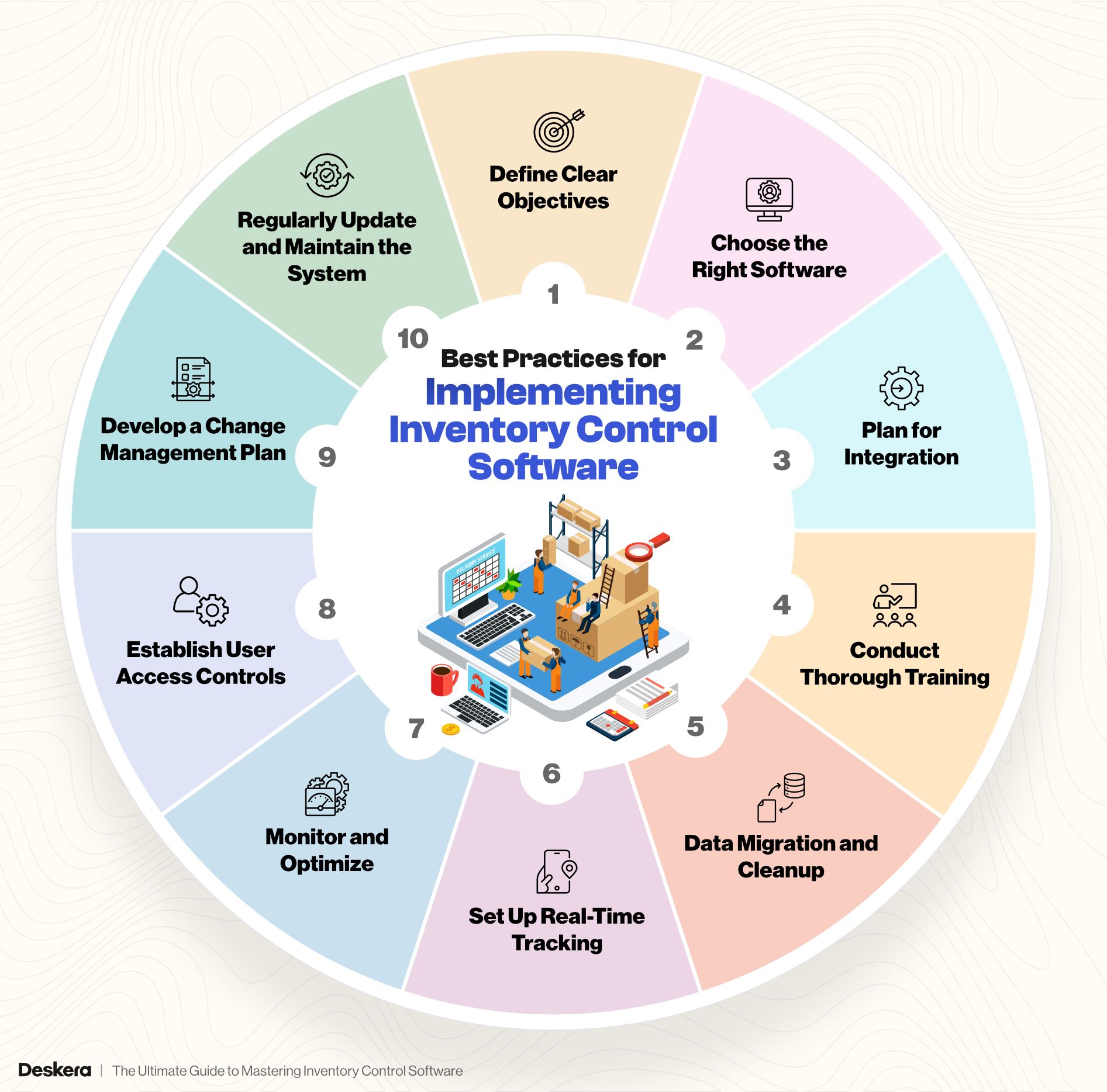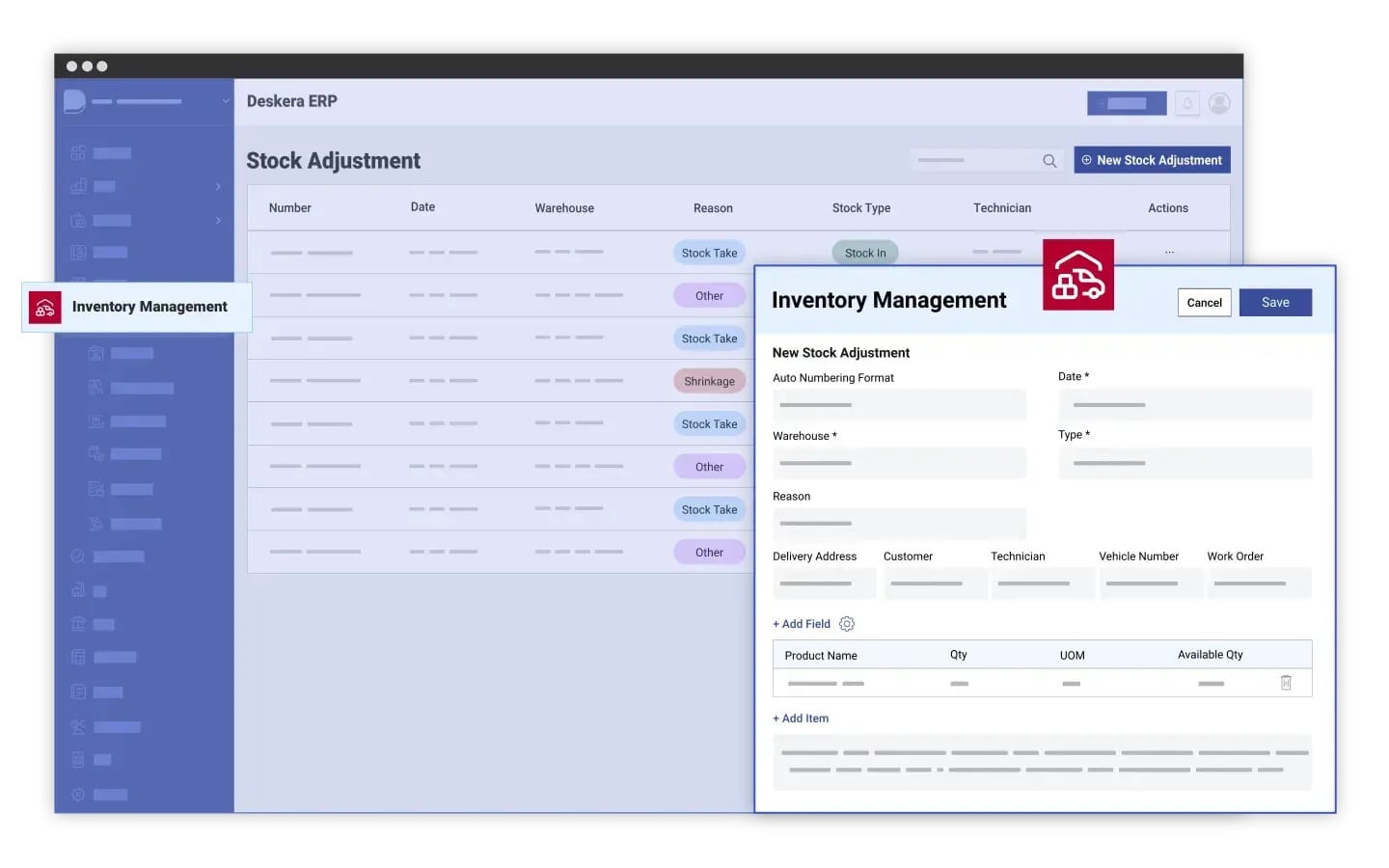In today’s fast-paced business environment, managing inventory efficiently is crucial to maintaining a competitive edge. With the global inventory management software market valued at $2.13 billion in 2023 and projected to reach $4.84 billion by 2032, it's evident that businesses are increasingly recognizing the importance of sophisticated inventory control systems. These tools not only streamline operations but also provide valuable insights that drive decision-making and enhance overall efficiency.
Inventory control software has evolved significantly, offering a range of features designed to tackle the complexities of modern supply chains. From real-time tracking and automated reordering to advanced reporting and analytics, these systems help businesses optimize inventory levels, reduce costs, and improve customer satisfaction. The right software can transform how companies manage their stock, providing a clear view of inventory status and trends that are essential for strategic planning.
Among the leading solutions in the market is Deskera ERP, which offers a robust suite of tools tailored for comprehensive inventory management. Deskera ERP stands out with its advanced MRP features, mobile accessibility, and AI-powered insights, making it a powerful choice for businesses aiming to refine their inventory control processes. With its focus on real-time data and integration capabilities, Deskera ERP ensures that companies can stay agile and responsive to market demands.
This guide will walk you through the essentials of mastering inventory control software, exploring key features, benefits, and best practices. Whether you're considering implementing a new system or looking to optimize your existing one, understanding how to leverage these tools effectively will be key to driving your business's success in the evolving landscape of inventory management.
What is Inventory Control Software?
Inventory control software is a specialized tool designed to manage and streamline inventory processes, ensuring that businesses maintain optimal stock levels while minimizing costs. At its core, inventory control software helps organizations track inventory in real-time, manage orders, and forecast future needs. This software is essential for maintaining a smooth supply chain and achieving operational efficiency.
For manufacturing businesses, manufacturing inventory control software offers advanced features tailored to the unique challenges of managing raw materials and finished goods. This type of software integrates with other systems to provide a comprehensive view of inventory across various stages of production, facilitating better decision-making and reducing waste.
Small businesses can benefit significantly from inventory control software designed specifically for their needs. Inventory control software for small businesses often includes user-friendly interfaces and scalable features that grow with the company.
It helps manage stock levels, track sales, and automate reordering processes, making it an invaluable tool for businesses looking to optimize their inventory management without extensive overhead.
Warehouse inventory control software is another critical application, focusing on managing inventory within large storage facilities. This software integrates with warehouse management systems to streamline processes like receiving, picking, and shipping, ensuring that inventory levels are accurately tracked and managed. Additionally, inventory management apps and software offer flexibility for on-the-go access, providing real-time updates and insights to help businesses make informed decisions.
In summary, inventory management software, whether for small businesses or large warehouses, plays a crucial role in maintaining effective inventory control. By leveraging these tools, companies can enhance their inventory management practices, reduce operational costs, and improve overall efficiency.
Types of Inventory Control Software
Inventory control software comes in various types, each designed to cater to different aspects of inventory management and business needs.
Here’s a look at the most common types of inventory control software and their key features:
1. Basic Inventory Management Software
- Description: Ideal for small businesses or startups, this type of software offers essential features for tracking inventory levels, managing orders, and generating basic reports.
- Features: Stock tracking, order management, basic reporting.
- Best For: Small businesses seeking straightforward inventory management without advanced functionalities.
2. Manufacturing Inventory Control Software
- Description: Tailored for manufacturing industries, this software integrates with production systems to manage raw materials, work-in-progress, and finished goods.
- Features: Production planning, bill of materials, work order management, integration with ERP systems.
- Best For: Manufacturing companies that require detailed tracking of inventory throughout the production cycle.
3. Warehouse Inventory Control Software
- Description: Designed to manage inventory within large warehouses, this software focuses on optimizing storage, picking, packing, and shipping processes.
- Features: Barcode scanning, real-time tracking, warehouse layout management, advanced reporting.
- Best For: Businesses with extensive warehousing operations looking to improve efficiency and accuracy in inventory handling.
4. Inventory Management System
- Description: A comprehensive solution that integrates with other business systems to provide a holistic view of inventory across various channels and locations.
- Features: Multi-location tracking, demand forecasting, integration with sales and procurement systems.
- Best For: Mid-sized to large businesses that need robust inventory management capabilities and integration with other enterprise systems.
5. Inventory Management Software for Small Business
- Description: This software is tailored for small businesses, offering a balance between essential features and ease of use.
- Features: User-friendly interface, cloud-based access, basic analytics, and reporting.
- Best For: Small business owners who need effective inventory management without the complexity of larger systems.
6. Inventory Management App
- Description: Mobile applications that provide inventory management capabilities on the go, allowing users to manage and track inventory from their smartphones or tablets.
- Features: Mobile access, barcode scanning, real-time updates, and notifications.
- Best For: Businesses needing flexibility and real-time inventory management from remote locations or on the move.
7. Advanced Inventory Control Systems
- Description: High-end solutions offering sophisticated features such as AI-driven analytics, automation, and advanced reporting.
- Features: Predictive analytics, automated reordering, AI integration, multi-channel support.
- Best For: Large enterprises or businesses with complex inventory management needs looking for advanced capabilities and high customization.
8. Cloud-Based Inventory Control Software
- Description: Hosted on the cloud, this software provides access from any location with an internet connection, offering flexibility and scalability.
- Features: Remote access, automatic updates, data backup, and integration with other cloud-based applications.
- Best For: Businesses that need to access inventory data from multiple locations or want to avoid the complexities of on-premises hardware.
9. Retail Inventory Management Software
- Description: Specifically designed for retail businesses, this software helps manage inventory across multiple retail locations and integrates with point-of-sale (POS) systems.
- Features: Sales tracking, stock level management, promotional management, and integration with POS systems.
- Best For: Retailers looking to manage inventory in physical stores and online channels, often with features tailored to retail sales and promotions.
10. E-commerce Inventory Control Software
- Description: Designed for online retailers, this software focuses on managing inventory across e-commerce platforms and synchronizing stock levels with online sales channels.
- Features: Integration with e-commerce platforms, real-time stock updates, order fulfillment tracking, and multi-channel support.
- Best For: E-commerce businesses that need to synchronize inventory between their online store, marketplaces, and possibly physical locations.
11. Asset Management Software
- Description: While similar to inventory control, asset management software focuses on tracking and managing physical assets beyond traditional inventory, such as equipment and machinery.
- Features: Asset tracking, maintenance scheduling, depreciation management, and compliance tracking.
- Best For: Organizations that need to manage not just inventory but also valuable assets and equipment.
12. Demand Forecasting Software
- Description: Specializes in predicting future inventory needs based on historical data, market trends, and other factors.
- Features: Predictive analytics, trend analysis, and integration with inventory management systems for automated adjustments.
- Best For: Businesses that want to improve their forecasting accuracy to optimize stock levels and reduce excess inventory.
13. Supply Chain Inventory Management Software
- Description: Focuses on managing inventory across the entire supply chain, including supplier relationships, procurement, and distribution.
- Features: Supply chain visibility, supplier management, procurement tracking, and logistics integration.
- Best For: Companies with complex supply chains that need to coordinate inventory management across multiple stakeholders and stages.
By choosing the right type of inventory control software, businesses can enhance their inventory management processes, improve operational efficiency, and drive better decision-making.
Key Features of Inventory Control Software
Inventory control software is designed to streamline and optimize inventory management, offering a range of features tailored to various business needs.
Here are some key features to look for:
1. Real-Time Inventory Tracking
- Description: Provides up-to-the-minute updates on stock levels, allowing businesses to monitor inventory status and avoid discrepancies.
- Best For: Ensuring accurate and timely information across all inventory locations.
2. Automated Reordering
- Description: Automatically generates purchase orders or restocks items when inventory levels fall below predefined thresholds, preventing stockouts and overstocking.
- Best For: Maintaining optimal inventory levels without manual intervention.
3. Barcode and RFID Integration
- Description: Utilizes barcode scanning and RFID technology for efficient tracking, updating, and managing inventory.
- Best For: Speeding up inventory processes and reducing human error.
4. Advanced Reporting and Analytics
- Description: Offers detailed reports and analytics on inventory performance, sales trends, and stock levels, aiding in data-driven decision-making.
- Best For: Gaining insights into inventory trends and optimizing stock management strategies.
5. Multi-Location Support
- Description: Manages inventory across multiple locations, providing a consolidated view of stock levels and facilitating inter-location transfers.
- Best For: Businesses with operations in different geographic areas or multiple warehouses.
6. Integration with Other Business Systems
- Description: Seamlessly integrates with ERP, CRM, and e-commerce platforms to synchronize inventory data across various business functions.
- Best For: Ensuring cohesive and streamlined operations across different business departments.
7. Mobile Access and Inventory Management Apps
- Description: Provides mobile access through apps, allowing users to manage inventory from smartphones or tablets, enhancing flexibility and accessibility.
- Best For: On-the-go inventory management and real-time updates from remote locations.
8. Demand Forecasting
- Description: Uses historical data and market trends to predict future inventory needs, helping to align stock levels with anticipated demand.
- Best For: Reducing excess inventory and improving stock availability based on accurate forecasts.
9. User Access Controls
- Description: Manages user permissions and access levels within the inventory control system to ensure security and proper handling of inventory data.
- Best For: Protecting sensitive inventory data and maintaining control over who can perform various tasks.
10. Customizable Alerts and Notifications
- Description: Sends alerts and notifications for critical inventory events, such as low stock levels or order confirmations, to keep users informed.
- Best For: Staying proactive in inventory management and responding quickly to potential issues.
These features collectively enhance the functionality of inventory control software, providing businesses with the tools needed to efficiently manage their inventory and optimize their operations.
Benefits of Using Inventory Control Software
Implementing inventory control software can substantially improve business operations, offering a range of benefits that enhance efficiency, accuracy, and profitability.
Here’s a closer look at the key advantages:
1. Improved Accuracy
Inventory control software significantly reduces manual data entry errors by automating the tracking and updating of inventory. This automation ensures that stock records are precise and discrepancies are minimized.
Accurate inventory data is crucial for making informed decisions, managing stock levels effectively, and ensuring customer satisfaction.
2. Enhanced Efficiency
By automating routine tasks such as stock level monitoring, order processing, and reordering, inventory control software streamlines operations and reduces the administrative workload. This increased efficiency allows staff to focus on more strategic tasks rather than spending time on repetitive manual processes.
3. Cost Savings
Effective inventory control helps in managing excess inventory and preventing stockouts. By optimizing inventory levels, businesses can reduce carrying costs and avoid lost sales opportunities. Additionally, better inventory management can lead to more favorable terms with suppliers, further enhancing cost savings and improving cash flow.
4. Increased Customer Satisfaction
Inventory control software ensures that products are consistently available when customers need them. By reducing the risk of stockouts and improving order fulfillment rates, businesses can enhance the overall customer experience. Reliable product availability boosts customer loyalty and satisfaction.
5. Better Decision-Making
The software provides detailed insights and comprehensive reports on inventory performance, sales trends, and stock levels. These analytics aid in strategic planning and help businesses make informed decisions. Access to accurate and actionable data allows companies to respond proactively to market changes and optimize their inventory management strategies.
6. Scalability and Flexibility
Inventory control software is designed to scale with business growth and adapt to changing needs. Whether you are managing a small business or overseeing large-scale warehouse operations, the software can accommodate evolving inventory management requirements. This scalability ensures that businesses can continue to operate efficiently as they expand.
7. Improved Inventory Turnover
Optimizing stock levels with inventory control software helps reduce excess inventory and improves turnover rates. Efficient inventory management leads to better use of warehouse space and resources, ultimately increasing profitability by ensuring that inventory moves through the supply chain more effectively.
8. Enhanced Compliance and Security
The software often includes features like user access controls and audit trails to protect sensitive inventory data and ensure compliance with industry regulations. These security measures safeguard against unauthorized access and ensure that inventory data remains secure and compliant with regulatory requirements.
9. Real-Time Visibility
Real-time visibility into inventory levels, sales, and orders across multiple locations is a key feature of inventory control software. This up-to-date information enables better coordination and control, facilitating timely decision-making and efficient inventory management throughout the organization.
10. Integration with Other Systems
Inventory control software can seamlessly integrate with ERP, CRM, and e-commerce platforms, ensuring a consistent flow of data across various business functions. This integration enhances overall operational efficiency by synchronizing inventory data with other critical business processes, leading to improved coordination and performance.
By leveraging inventory control software, businesses can achieve these benefits, ultimately leading to a more efficient, cost-effective, and customer-focused operation.
Best Practices for Implementing Inventory Control Software
Successfully implementing inventory control software requires careful planning and execution. Following these best practices can help ensure that your software deployment is smooth and yields the maximum benefits:

1. Define Clear Objectives
- Description: Before selecting or implementing inventory control software, clearly define your business objectives and what you hope to achieve with the software. This includes goals like reducing excess inventory, improving accuracy, or enhancing reporting capabilities.
- Best Practice: Align software features with your specific business needs to ensure it meets your objectives effectively.
2. Choose the Right Software
- Description: Select inventory control software that fits your business size, industry requirements, and operational complexity. Consider factors like scalability, integration capabilities, and user-friendliness.
- Best Practice: Evaluate various software options and choose one that aligns with your current needs and future growth.
3. Plan for Integration
- Description: Ensure that the inventory control software integrates seamlessly with other systems such as ERP, CRM, and e-commerce platforms. Proper integration helps maintain data consistency and streamlines operations.
- Best Practice: Work with vendors to plan and test integrations before going live to avoid disruptions.
4. Conduct Thorough Training
- Description: Provide comprehensive training for your staff to ensure they understand how to use the inventory control software effectively. This includes training on software features, best practices, and troubleshooting.
- Best Practice: Offer ongoing support and refresher training to keep staff updated on new features and practices.
5. Data Migration and Cleanup
- Description: Properly migrate and clean up existing inventory data before implementing the new software. This ensures that the new system starts with accurate and up-to-date information.
- Best Practice: Conduct a thorough audit of existing inventory data and clean it up before importing it into the new system.
6. Set Up Real-Time Tracking
- Description: Utilize the software’s real-time tracking capabilities to monitor inventory levels and movements. This feature is crucial for maintaining accurate stock records and managing inventory effectively.
- Best Practice: Configure and test real-time tracking features to ensure they provide accurate and timely updates.
7. Monitor and Optimize
- Description: Continuously monitor the software’s performance and the accuracy of inventory data. Use the software’s reporting and analytics features to identify areas for improvement and optimize inventory management processes.
- Best Practice: Regularly review performance metrics and make adjustments to optimize inventory control and address any issues.
8. Establish User Access Controls
- Description: Implement user access controls to manage who can view or modify inventory data. This helps maintain security and ensures that only authorized personnel can perform critical tasks.
- Best Practice: Set up and regularly review user permissions to ensure they align with roles and responsibilities.
9. Develop a Change Management Plan
- Description: Prepare your organization for changes brought by the new inventory control software. This includes communicating changes, managing expectations, and addressing any resistance to the new system.
- Best Practice: Develop a comprehensive change management plan to facilitate a smooth transition and gain buy-in from stakeholders.
10. Regularly Update and Maintain the System
- Description: Keep the inventory control software updated with the latest features and security patches. Regular maintenance ensures that the software continues to function optimally and adapts to evolving business needs.
- Best Practice: Schedule regular updates and maintenance checks to ensure the software remains current and effective.
By following these best practices, you can ensure a successful implementation of inventory control software, leading to enhanced efficiency, accuracy, and overall inventory management.
Tackling Inventory Control Challenges: Solutions and Software Benefits
Managing inventory effectively can present numerous challenges, but the right strategies and tools can help overcome these obstacles. Here’s a look at common inventory control challenges and the solutions that inventory control software can provide:
1. Inaccurate Inventory Data
- Challenge: Manual inventory tracking is prone to errors, leading to discrepancies between actual stock levels and recorded data.
- Solution: Inventory control software automates data entry and tracking, ensuring that stock records are accurate and up-to-date. This automation minimizes human error and provides real-time data on inventory levels.
2. Excess Inventory
- Challenge: Holding too much inventory can lead to increased carrying costs and potential obsolescence.
- Solution: Inventory control software uses advanced forecasting and demand planning tools to help businesses maintain optimal inventory levels. By analyzing sales trends and historical data, the software helps prevent overstocking and reduces carrying costs.
3. Stockouts and Lost Sales
- Challenge: Running out of stock can result in lost sales opportunities and customer dissatisfaction.
- Solution: Automated reordering and real-time tracking features in inventory control software ensure that stock levels are maintained and reorder points are met. This helps prevent stockouts and ensures product availability.
4. Inefficient Order Fulfillment
- Challenge: Slow and inaccurate order fulfillment can impact customer satisfaction and operational efficiency.
- Solution: Inventory control software integrates with order management systems to streamline the fulfillment process. It provides accurate picking, packing, and shipping information, which speeds up order processing and improves accuracy.
5. Poor Inventory Visibility
- Challenge: Lack of visibility into inventory across multiple locations can lead to inefficient stock management and coordination issues.
- Solution: Real-time tracking and centralized inventory management features of inventory control software offer comprehensive visibility into stock levels across all locations. This improves coordination and ensures better management of inventory resources.
6. Complex Integration with Other Systems
- Challenge: Difficulty in integrating inventory systems with other business applications can result in fragmented data and inefficient processes.
- Solution: Many inventory control software solutions offer seamless integration with ERP, CRM, and e-commerce platforms. This integration ensures consistent data flow and improves overall business processes.
7. High Administrative Costs
- Challenge: Manual inventory management processes can be time-consuming and labor-intensive, leading to higher administrative costs.
- Solution: Automation of routine inventory tasks through software reduces the need for manual intervention, cutting down administrative costs and freeing up staff to focus on more strategic activities.
8. Data Security and Compliance
- Challenge: Ensuring the security and compliance of inventory data is crucial for protecting sensitive information and meeting regulatory requirements.
- Solution: Inventory control software often includes features like user access controls and audit trails to maintain data security and compliance. These features help protect sensitive inventory information and ensure adherence to regulatory standards.
By addressing these challenges with the help of inventory control software, businesses can enhance their inventory management processes, leading to greater efficiency, accuracy, and overall success in their operations.
Future Trends in Inventory Control Software
As technology continues to evolve, so does the landscape of inventory control software. Here are some key trends shaping the future of inventory management:
1. Advanced AI and Machine Learning
- Trend: AI and machine learning are becoming integral to inventory control software, offering predictive analytics and automated decision-making.
- Impact: Enhances demand forecasting accuracy and optimizes inventory levels by analyzing vast amounts of data for insights.
2. Integration with IoT Devices
- Trend: The Internet of Things (IoT) is facilitating real-time inventory tracking through connected sensors and smart devices.
- Impact: Provides accurate, real-time visibility of inventory across the supply chain, improving stock management and reducing losses.
3. Enhanced Automation
- Trend: Automation is expanding beyond basic tasks to include more complex processes such as automated replenishment and dynamic pricing.
- Impact: Streamlines operations, reduces manual errors, and improves efficiency in inventory management.
4. Cloud-Based Solutions
- Trend: Cloud-based inventory control software is increasingly popular due to its scalability, accessibility, and cost-effectiveness.
- Impact: Offers flexibility for businesses of all sizes, with easy access to inventory data from anywhere and automatic updates.
5. Blockchain Technology
- Trend: Blockchain is being explored for its potential to enhance transparency and security in inventory management.
- Impact: Improves traceability and reduces fraud by providing an immutable record of inventory transactions.
6. Advanced Analytics and Reporting
- Trend: Sophisticated analytics tools are being integrated to provide deeper insights into inventory performance and trends.
- Impact: Enables better strategic decision-making by offering detailed reports and actionable data.
7. Mobile and Remote Access
- Trend: Mobile compatibility is becoming essential, allowing users to manage inventory and track shipments on the go.
- Impact: Increases flexibility and responsiveness, allowing for real-time updates and management from mobile devices.
8. Integration with E-commerce Platforms
- Trend: Seamless integration with e-commerce platforms is essential for managing online sales and inventory.
- Impact: Ensures synchronization between online and offline inventories, improving accuracy and customer satisfaction.
These trends reflect the ongoing advancements in inventory control software, driving greater efficiency, accuracy, and adaptability in inventory management.
Deskera ERP: A Comprehensive Solution for Inventory Control
Deskera ERP offers a robust and versatile inventory control software solution designed to streamline and enhance inventory management for businesses of all sizes. With its comprehensive suite of features, Deskera ERP addresses key challenges in inventory control and delivers significant benefits.

Advanced Inventory Management
Deskera ERP provides a sophisticated inventory management system that offers real-time tracking of stock levels, movements, and transactions. This feature ensures that businesses have up-to-date information on inventory across multiple locations, helping to maintain optimal stock levels and avoid both stockouts and overstock situations.
Automated Reordering and Demand Forecasting
One of the standout features of Deskera ERP is its automated reordering and demand forecasting capabilities. The software uses historical sales data and predictive analytics to forecast demand accurately, enabling businesses to automate reorder processes. This reduces the risk of stockouts, minimizes excess inventory, and helps maintain smooth operational flow.
Integration and Scalability
Deskera ERP excels in providing seamless integration with various business functions such as sales, procurement, and finance. This integration ensures consistent data flow across the organization, enhancing overall efficiency. Additionally, Deskera ERP is scalable, making it suitable for both small businesses and large enterprises. It adapts to growing business needs without requiring significant additional investment.
Real-Time Reporting and Analytics
The software features advanced reporting and analytics tools that offer detailed insights into inventory performance, sales trends, and stock levels. Businesses can generate customized reports and dashboards to make data-driven decisions and optimize inventory management strategies.
Cloud-Based Accessibility
As a cloud-based solution, Deskera ERP offers the flexibility to access inventory data from anywhere, at any time. This is particularly beneficial for businesses with multiple locations or remote teams, as it allows for real-time updates and management from any device with an internet connection.
Enhanced Security and Compliance
Deskera ERP includes robust security features such as user access controls and audit trails to ensure that inventory data is secure and compliant with industry regulations. This helps protect sensitive information and maintain regulatory adherence.
Deskera ERP stands out as a comprehensive inventory control software solution that combines advanced features, seamless integration, and scalability. Its ability to provide real-time tracking, automated processes, and detailed analytics makes it an invaluable tool for businesses aiming to optimize their inventory management and drive operational efficiency.
Key Takeaways
- Inventory control software is increasingly vital as the global market grows, with its value projected to nearly double by 2032. Adopting sophisticated solutions like Deskera ERP can enhance efficiency, accuracy, and profitability in inventory management.
- Inventory control software is essential for managing stock levels, orders, and deliveries efficiently. It automates processes, provides real-time visibility, and integrates with other systems to streamline inventory management across various business sizes and types.
- Different types of inventory control software cater to specific business needs, from basic systems for small businesses to advanced solutions for large enterprises. Understanding these types helps businesses choose the right software for their operational requirements and scalability.
- Essential features of inventory control software include real-time tracking, automated reordering, and integration capabilities. These features ensure accurate inventory management, improve operational efficiency, and support data-driven decision-making.
- Implementing inventory control software offers numerous benefits, including improved accuracy, cost savings, and enhanced customer satisfaction. It streamlines operations, reduces manual errors, and optimizes inventory levels for better overall performance.
- Successful implementation of inventory control software requires clear objectives, proper software selection, thorough staff training, and effective data migration. Following best practices ensures a smooth transition and maximizes the software's benefits.
- Addressing common inventory control challenges, such as inaccurate data and stockouts, is achievable with the right software solutions. Inventory control software provides automated solutions, real-time tracking, and data integration to overcome these obstacles effectively.
- Future trends in inventory control software, such as AI integration, IoT connectivity, and cloud-based solutions, are shaping the evolution of inventory management. Staying updated with these trends helps businesses leverage advanced technologies for enhanced efficiency and adaptability.
Related Articles












